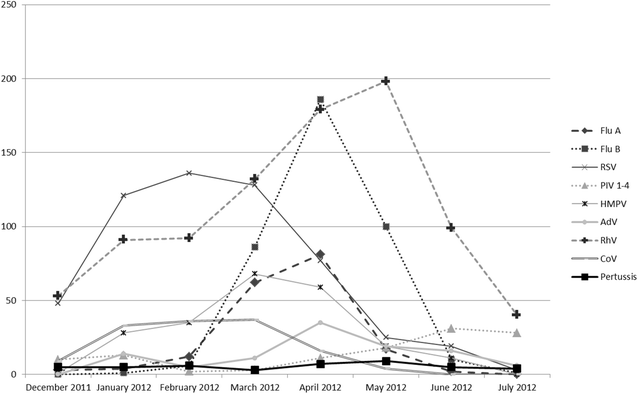Comparison of molecular detection methods for pertussis in children during a state-wide outbreak
- PMID: 27121506
- PMCID: PMC4847268
- DOI: 10.1186/s12941-016-0142-4
Comparison of molecular detection methods for pertussis in children during a state-wide outbreak
Abstract
A state-wide pertussis outbreak occurred in Washington during the winter-spring months of 2012, concurrent with respiratory viral season. We compared performance characteristics of a laboratory-developed pertussis PCR (LD-PCR for Bordetella pertussis, Bordetella parapertussis, and Bordetella holmesii) and rapid multiplex PCR (RM-PCR) for respiratory viruses (FilmArray™, BioFire, B. pertussis data unblinded following FDA approval post outbreak). We analyzed three cohorts of patients using physician testing orders as a proxy for clinical suspicion for pertussis or respiratory viruses: Cohort 1, tested by LD-PCR for pertussis pathogens only by nasopharyngeal swab; Cohort 2, by RM-PCR for respiratory viruses only by mid-nasal turbinate swab; and Cohort 3, by both methods. B. pertussis was detected in a total of 25 of the 490 patients in Cohort 3 in which LD-PCR detected 20/25 (80 %) cases and the RM-PCR detected 24/25 (96 %; p = 0.2). Pertussis pathogens were detected in 21/584 (3.6 %) of samples from Cohort 1 where clinicians had a relatively strong suspicion for pertussis. In contrast, B. pertussis was detected in only 4/3071 (0.1 %) specimens from Cohort 2 where suspicion for pertussis was lower (p < 0.001 for comparison with Cohort 1). In summary, the two laboratory methods were comparable for the detection of B. pertussis.
Keywords: Bordetella pertussis; Rapid diagnosis; Respiratory viruses.
Figures
References
Publication types
MeSH terms
Substances
LinkOut - more resources
Full Text Sources
Other Literature Sources
Medical
Research Materials


